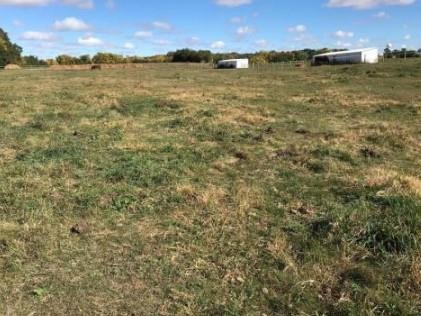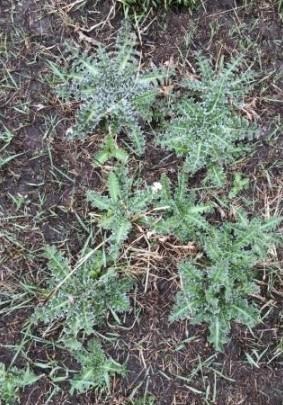By Meaghan Anderson
As pastures begin to green up, unwanted weeds may start to pop up too. Early spring is an excellent time to clean up biennials, winter annuals, and some perennials present in pastures. This article will focus on management considerations for weeds we might find in the early spring.

Proper identification of the weed species is crucial to choosing appropriate management strategies. The Iowa State University Weed Identification Field Guide or online weed keys, such as the one offered by the University of Missouri, can assist in helping you determine the proper weed species. Once we properly identify the weed, we can work to determine the best management tactics.
Why are the weeds there?
The presence of weeds in established forage fields can help us identify other issues we need to address in our forages. A healthy stand of an appropriate forage species is highly competitive and able to prevent the establishment of most weedy species. Simply killing the weeds with a herbicide without addressing the underlying cause for the weeds generally will allow rapid reestablishment of the weeds.
Pastures may thin due to natural aging of the stand, poor species by site selection, pest issues, poor fertility, overgrazing, or heavy traffic. Interseeding is one approach to improving the pasture stand and crowding out weeds and can be a useful technique if other management concerns like poor fertility don’t exist. Detailed information on how to approach the task of interseeding forages can be found in the ICM Blog “Making the Best of a Thin Situation.”
Winter annuals
Winter annuals germinate in the fall and overwinter to produce seed in the spring, while biennials and perennials survive for longer periods of time.
The presence of winter annual weeds (and sometimes biennial weeds) may be a sign that the forage stand has begun to thin out, creating open areas where the weeds are able to establish in late summer and fall. A healthy forage stand eliminates most of the ‘safe sites’ for establishment of winter annuals. If this is the case, investigating the cause of a thin pasture is important.
Winter annuals like shepherdspurse, henbit, field pennycress, horseweed, hedge mustard, and others may appear in Iowa pastures. As winter annuals are often present in thin pastures, determining the root cause of open space is generally more effective than the temporary fix of killing the weeds with a herbicde. If necessary, winter annuals should be easy to control to prevent seed production. Mowing may be an effective option to reduce seed production for some species that grow tall and produce upright stems. It is unlikely to completely prevent seed additions to the soil for many winter annual species. Mowing should be timed to clip the bolted stems of winter annuals prior to the production of viable seed. If someone is planning to reseed an area, tillage would be an effective method to disturb winter annual weeds and allow for immediate reseeding.
Early-spring herbicide treatments, particularly of growth regulator herbicides, are effective for winter annuals in the spring. The treatment will be most effective if timed after winter annuals have resumed growth but before they’ve bolted to produce seed.
Biennials and perennials
Several biennial species are common in Iowa pastures, including musk thistle, bull thistle, wild carrot, wild parsnip, poison hemlock, and common burdock. In the early spring, biennials form a basal rosette, a circular arrangement of leaves at ground level. Once temperatures warm, they’ll bolt and be much more difficult to control.

Musk thistle rosettes greening up in the early spring.
Herbicide applications in the spring prior to bolting can be very effective against these species, but timeliness can be a challenge. A well-timed mowing prior to seed production is another option to prevent additions to the seedbank. Monitor populations after mowing or herbicide treatment to evaluate the effectiveness of control. A second clipping may be necessary as plants will often produce a second flower stalk after mowing.
Early spring is not the best time to control most perennials, though treatments may help suppress perennial growth early.
While early spring is a time of lush pasture growth and an abundance of forage, some Iowa pastures have been through several rough seasons of too dry or too wet conditions. Scout your pastures this spring and determine whether weed management should be on the spring to-do list. Regardless of the weeds that are present in your pasture, there are viable control options that can be implemented for effective control. Staying on top of the weeds and identifying any underlying causes of their presence will simplify controlling weed problems. Consult weed control guides or your local agronomist for specific herbicide recommendations for your weed spectrum.
Source : iastate.edu